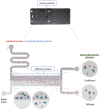Microfluidic Diffusion Sizing Applied to the Study of Natural Products and Extracts That Modulate the SARS-CoV-2 Spike RBD/ACE2 Interaction
- PMID: 38138562
- PMCID: PMC10745392
- DOI: 10.3390/molecules28248072
Microfluidic Diffusion Sizing Applied to the Study of Natural Products and Extracts That Modulate the SARS-CoV-2 Spike RBD/ACE2 Interaction
Abstract
The interaction between SARS-CoV-2 spike RBD and ACE2 proteins is a crucial step for host cell infection by the virus. Without it, the entire virion entrance mechanism is compromised. The aim of this study was to evaluate the capacity of various natural product classes, including flavonoids, anthraquinones, saponins, ivermectin, chloroquine, and erythromycin, to modulate this interaction. To accomplish this, we applied a recently developed a microfluidic diffusional sizing (MDS) technique that allows us to probe protein-protein interactions via measurements of the hydrodynamic radius (Rh) and dissociation constant (KD); the evolution of Rh is monitored in the presence of increasing concentrations of the partner protein (ACE2); and the KD is determined through a binding curve experimental design. In a second time, with the protein partners present in equimolar amounts, the Rh of the protein complex was measured in the presence of different natural products. Five of the nine natural products/extracts tested were found to modulate the formation of the protein complex. A methanol extract of Chenopodium quinoa Willd bitter seed husks (50 µg/mL; bisdesmoside saponins) and the flavonoid naringenin (1 µM) were particularly effective. This rapid selection of effective modulators will allow us to better understand agents that may prevent SARS-CoV-2 infection.
Keywords: dissociation constant; hydrodynamic radius; protein-protein interaction.
Conflict of interest statement
The authors declare no conflict of interest. The funders had no role in the design of the study; in the collection, analyses, or interpretation of data; in the writing of the manuscript; or in the decision to publish the results.
Figures






Similar articles
-
Luteolin inhibits spike protein of severe acute respiratory syndrome coronavirus-2 (SARS-CoV-2) binding to angiotensin-converting enzyme 2.Phytother Res. 2023 Aug;37(8):3508-3521. doi: 10.1002/ptr.7826. Epub 2023 May 11. Phytother Res. 2023. PMID: 37166054
-
Exploring the Role of Glycans in the Interaction of SARS-CoV-2 RBD and Human Receptor ACE2.Viruses. 2021 May 17;13(5):927. doi: 10.3390/v13050927. Viruses. 2021. PMID: 34067878 Free PMC article.
-
Interactions of angiotensin-converting enzyme-2 (ACE2) and SARS-CoV-2 spike receptor-binding domain (RBD): a structural perspective.Mol Biol Rep. 2023 Mar;50(3):2713-2721. doi: 10.1007/s11033-022-08193-4. Epub 2022 Dec 23. Mol Biol Rep. 2023. PMID: 36562937 Free PMC article. Review.
-
Computational modeling of the effect of five mutations on the structure of the ACE2 receptor and their correlation with infectivity and virulence of some emerged variants of SARS-CoV-2 suggests mechanisms of binding affinity dysregulation.Chem Biol Interact. 2022 Dec 1;368:110244. doi: 10.1016/j.cbi.2022.110244. Epub 2022 Nov 3. Chem Biol Interact. 2022. PMID: 36336003 Free PMC article.
-
Inhibition of S-protein RBD and hACE2 Interaction for Control of SARSCoV- 2 Infection (COVID-19).Mini Rev Med Chem. 2021;21(6):689-703. doi: 10.2174/1389557520666201117111259. Mini Rev Med Chem. 2021. PMID: 33208074 Review.
References
-
- WHO World Health Orgarnization. [(accessed on 21 October 2023)]. Available online: https://covid19.who.int/table.
-
- Goel N., Jain A., Kumari A. The role of ACE2 receptor and its age related immunity in COVID-19. Int. J. Pharm. Sci. Rev. Res. 2020;63:190–194.
-
- Prashantha C.N., Gouthami K., Lavanya L., Bhavanam S., Jakhar A., Shakthiraju R.G., Suraj V., Sahana K.V., Sujana H.S., Guruprasad N.M., et al. Molecular screening of antimalarial, antiviral, anti-inflammatory and HIV protease inhibitors against spike glycoprotein of coronavirus. J. Mol. Graph. Model. 2021;102:107769. doi: 10.1016/j.jmgm.2020.107769. - DOI - PMC - PubMed
MeSH terms
Substances
LinkOut - more resources
Full Text Sources
Medical
Research Materials
Miscellaneous

